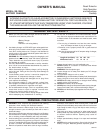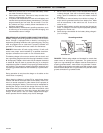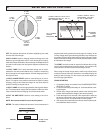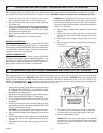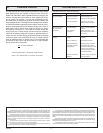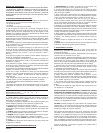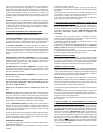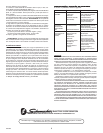
4
Sch589
1. Position AC power cord and DC charging cords to reduce
risk of damage by hood, door, or moving engine parts.
2. Stay clear of fan blades, belts, pulleys, and other parts that
can cause injury.
3. Check polarity of battery posts. Battery case will be marked
by each post: POSITIVE (POS, P, +) and NEGATIVE (NEG, N,
-). NOTE: The positive battery post usually has a larger
diameter than the negative post.
4. Determine which post of battery is ground (connected) to
chassis.
NOTE: The negative post is normally grounded.
OPERATING INSTRUCTIONS: CHARGING BATTERY IN VEHICLE
When charging battery in the vehicle, take care to determine the battery type and which post is grounded. To reduce risk of a spark
near battery, follow these steps when battery is installed in vehicle. WARNING: A spark near battery may cause battery explosion.
NEGATIVE GROUNDED POST
5A. For negative-grounded vehicle, connect POSITIVE (RED)
clip from battery charger to POSITIVE (POS, P, +) ungrounded
post of battery. Connect NEGATIVE (BLACK) clip to vehicle chas-
sis or engine block away from battery. Connect to a heavy gauge
metal part of the frame or engine block.
POSITIVE GROUNDED POST
5B. For positive-grounded vehicle, connect NEGATIVE
(BLACK) clip from battery charger to NEGATIVE (NEG, N, -) un-
grounded post of battery. Connect POSITIVE (RED) clip to ve-
hicle chassis or engine block away from battery. Connect to a
heavy gauge metal part of the frame or engine block.
WARNING: Do not connect clip to carburetor, fuel lines, or sheet-
metal body parts. NOTE: Attach clips to battery post and twist or
rock back and forth several times to make a good connection.
This tends to keep clips from slipping off terminals and helps to
reduce risk of sparking.
6. Make all desired settings before applying AC power to the
charger.
7. Observe the meter for proper response, if something does
not look right, refer to the trouble shooting section of this
manual.
8. When battery is fully charged, unplug charger from AC out-
let.
9. Remove charger clips from (1) chassis and (2) battery post,
in that order.
1. Check polarity of battery posts. Battery case will be marked
by each post: POSITIVE (POS, P, +) and NEGATIVE (NEG,
N, -). NOTE: The positive battery post usually has a larger
diameter than the negative post.
2. Attach a 24-inch long (or longer) 6-gauge (AWG) insulated
battery cable to NEGATIVE (NEG, N, -) battery post.
3. Connect POSITIVE (RED) charger clip to POSITIVE (POS,
P, +) post battery. Rock clip back and forth to make good
connection.
4. Position yourself and free end of 24 inch cable as far away
from battery as possible. Then connect NEGATIVE (BLACK)
charger clip to free end of cable.
WARNING: Do not face battery when making final connec-
tion. Rock clip back and forth to make a good connection.
5. Make all desired settings before applying AC power to the
charger.
6. Observe the meters for proper response, if something does
not look right, refer to the troubleshooting section of this
manual.
7. When battery is fully charged, unplug charger from AC power
source.
OPERATING INSTRUCTIONS: CHARGING BATTERY OUT OF VEHICLE
When charging battery out of vehicle, take care to determine the battery type. To reduce risk of a spark near battery, follow these steps
when battery is outside vehicle. WARNING: A spark near the battery may cause battery explosion. WARNING: When removing battery from
vehicle or boat, disconnect grounded pole first. When disconnecting, make sure all accessories are off, so as not to cause an arc.
(NOTE: A marine (boat) battery must be removed and charged on shore. (To charge on board requires special equipment designed for
marine use.) WARNING: When reinstalling battery, attach the ground post first.
E
F
8. When battery is fully charged and charger is unplugged,
(1) remove clip from end of Negative end of cable, and
(2) remove clip from Positive battery post, in that order.
9. Clean and store battery charger.
WARNING: Be sure area around battery is wll ventilated
while battery is being charged. Gas can be forcefully blown
away by using a piece of cardboard or other non-metallic
material as a fan.



